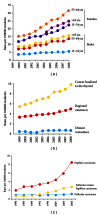Worldwide increasing incidence of thyroid cancer: update on epidemiology and risk factors
- PMID: 23737785
- PMCID: PMC3664492
- DOI: 10.1155/2013/965212
Worldwide increasing incidence of thyroid cancer: update on epidemiology and risk factors
Abstract
Background. In the last decades, thyroid cancer incidence has continuously and sharply increased all over the world. This review analyzes the possible reasons of this increase. Summary. Many experts believe that the increased incidence of thyroid cancer is apparent, because of the increased detection of small cancers in the preclinical stage. However, a true increase is also possible, as suggested by the observation that large tumors have also increased and gender differences and birth cohort effects are present. Moreover, thyroid cancer mortality, in spite of earlier diagnosis and better treatment, has not decreased but is rather increasing. Therefore, some environmental carcinogens in the industrialized lifestyle may have specifically affected the thyroid. Among potential carcinogens, the increased exposure to medical radiations is the most likely risk factor. Other factors specific for the thyroid like increased iodine intake and increased prevalence of chronic autoimmune thyroiditis cannot be excluded, while other factors like the increasing prevalence of obesity are not specific for the thyroid. Conclusions. The increased incidence of thyroid cancer is most likely due to a combination of an apparent increase due to more sensitive diagnostic procedures and of a true increase, a possible consequence of increased population exposure to radiation and to other still unrecognized carcinogens.
Figures

References
-
- Curado MP, Edwards B, Shin HR, et al. Cancer Incidence in Five Continents. No. 160. Vol. 9. Lyon, France: IARC; 2007. (IARC Scientific Publications).
-
- Jemal A, Siegel R, Xu J, Ward E. Cancer statistics, 2010. CA: A Cancer Journal for Clinicians. 2010;60(5):277–300. - PubMed
-
- dal Maso L, Lise M, Zambon P, et al. Incidence of thyroid cancer in Italy, 1991–2005: time trends and age-period-cohort effects. Annals of Oncology. 2011;22(4):957–963. - PubMed
-
- Aschebrook-Kilfoy B, Kaplan EL, Chiu BC, Angelos P, Grogan RH. The acceleration in papillary thyroid cancer incidence rates is similar among racial and ethnic groups in the United States. Annals of Surgical Oncology. 2013 - PubMed
LinkOut - more resources
Full Text Sources
Other Literature Sources
Medical

